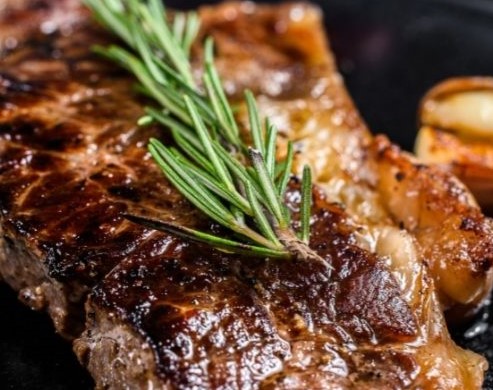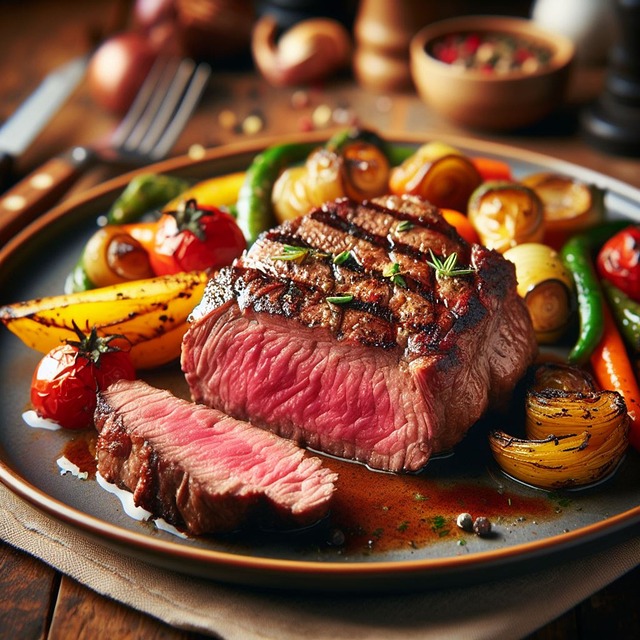Beef Health Benefits
Beef Health Benefits are numerious. Red meat is an excellent source of heme iron. However, you must consume in moderation and as part of a balanced diet.
What are the Properties of Beef?
Beef has many nutritional qualities:
1- A source of iron
2- Proteins
3- The nutritional values of beef
Beef Nutrients Facts:
Nutrients: Content per 100g
Water: 63.1g
Proteins: 19.2g
Lipids: 16.2g
Saturates: 6.75g
Monounsaturated fatty acids: 7.31g
Polyunsaturated fatty acids: 0.59g
Cholesterol: 67 mg
Learn More About Nutrients in Beef Steak
Beef Health Benefits:
Why Eat Beef? Is Red Meat Good for Your Health?
The National Nutrition and Health Program recommends limiting your meat consumption and favoring poultry. 500 grams of meat (excluding poultry) per week corresponds to 3 or 4 steaks. “Prefer poultry such as chicken without the skin, poultry escalope, etc. It is less fatty than other meats. If you eat other meats, also favor the least fatty cuts: veal escalope, lean pork tenderloin, flank steak, minced steak with 5% fat.”, underlines the Manger Bouger site. An easy tip: the recommended serving size is the palm-sized amount of cooked meat.
Beef is very rich in heme iron, this vatamin is present exclusively in animal food because it is associated with proteins such as hemoglobin. Why consume foods that are a source of iron? In the human body, iron is necessary for the transport and use of oxygen by red blood cells, as well as for the functioning of certain enzymes. “The balance between iron intake and loss is generally well regulated in healthy people. In fact, iron from red blood cells is efficiently recycled. A regular iron intake also makes it possible to maintain iron status. balanced iron”, details ANSES.
Before completing: “There are also some reserves in the liver, spleen and bone marrow which can be mobilized by the body to respond to increased needs in certain physiological situations such as pregnancy or growth “.
Beef Health Benefits:
Beef represents an interesting source of protein of animal origin. In the human body, they play several essential roles. Indeed, they have a structural function and “participate in the renewal of muscle tissues, skin appendages (hair, nails, body hair), bone matrix, skin, etc.” underlines Anses. In addition, proteins are involved in many physiological processes, such as digestive enzymes, hemoglobin, hormones, receptors, or immunoglobulins (antibodies). For example, a 100-gram serving of meat covers 30% of the necessary daily protein intake.
Another advantage of red meat is that it provides vitamin B12 to the body. Also called cobalamin, vitamin B12 is involved in propionate and vitamin B9 metabolism. Vitamin B12 deficiency is often noticed in people who follow a vegan diet because eggs provide it but are poorly absorbed, as well as meat, dairy products, offal, etc. In the majority of cases, a vitamin B12 deficiency results in anemia and is accompanied by “symptoms linked to impaired oxygen transport, such as fatigue or dyspnea”.
However, ANSES also reports other consequences of such a deficiency: “A vitamin B12 deficiency can also lead to neurological damage with progressive demyelination in the brain and spinal cord, which is accompanied by motor disorders. Sensitivity can also be associated with neuronal dysfunctions causing certain mental disorders: irritability, memory, and mood disorders. Among the B vitamins, red meat also contains vitamins B2, B3, and B6.

Beef Health Benefits
Learn More About Vitamins in Prime Rib Dish
This meat also provides antioxidant minerals such as copper and magnesium. As ANSES points out, in adulthood, the human body contains around 25 grams of magnesium, around 50 to 60% located in the bones and 25% in the muscles. What is it used for? Magnesium is involved in “energy production and reactions involving ATP (adenosine triphosphate), particularly in the intermediate metabolisms of carbohydrates, lipids, nucleic acids and proteins”. It is also essential for “maintaining cell membrane potential, ionic transport, regulating potassium flow”. Additionally, magnesium is involved in calcium metabolism.
It is also an excellent source of zinc, an essential trace element involved in many cellular functions. According to the Health Agency, it is engaged in the activity of nearly 300 enzymes and more than 2,500 transcription factors.
Is Beef A Fatty Meat?
Why Not Eat Too Much Beef?
Like pork and lamb, beef belongs to fatty meats. Obviously, it all depends on the portion consumed. A beef rib will be particularly fatty, while a beef shank has 161 calories for a 100-gram portion. As part of a healthy and balanced diet, a portion of beef has its place accompanied by vegetables.
For people who have cholesterol, red meats should be limited. In fact, they contain more saturated fats. This composition promotes the formation of atherosclerotic plaques, which cause cardiovascular accidents. Consumed in excessive quantities, red meat can harm the cardiovascular system.
Some recent studies point to the harmful effects of excessive consumption of red meat and, in particular, its possible role in the appearance of breast and prostate cancer. In 2021, a study published in the journal Nature Microbiology highlighted that the presence of the compound trimethylamine-N-oxide (TMAO), produced by certain intestinal bacteria, could increase the risk of cardiovascular problems.
How to Consume This Red Meat?

Beef Health Benefits
When it comes to cooking, it is important to cook red meat without forming potentially carcinogenic compounds. For this, it is recommended not to char the meat or overcook it on the grill. Pregnant women should choose “rare” cooking to limit the risk of poisoning.
To reduce the risk of bacteria proliferation, it is recommended to grind your meat just before consumption and ensure hygiene and reasonable maintenance of kitchen utensils—so many measures to combat the appearance of strains of E. coli. Although the majority of strains remain harmless, they can cause significant diarrhea or even death in the most serious cases. Most often, the most contaminated in epidemics are ground beef, consumed raw or undercooked.
Red meat is used in many popular recipes worldwide: carpaccio (with olive oil and parmesan), tartare, hamburgers, beef bourguignon, minced steak, prime rib, etc. You can also make a homemade marinade with lemon juice, olive oil, spices, etc. Depending on taste, you can also add the aromatics of your choice: honey, soy sauce, etc.
For offal lovers, the tongue, heart, and liver can also be eaten.

How to Store Red Meat?
It is recommended that cut meats be kept in the refrigerator for a maximum of four days in the original paper. Ground meat must be consumed within 12 hours of purchase, and trash products can be kept for 24 hours.
Additional Information:
How to Choose The Cooking Method?
There are different types of cooking for red meat. Beef can be blue (with a barely warm and very red interior), rare (with a slightly less red interior), medium (with a more pink interior), or well done with complete cooking and uniform.
HOW TO COOK BEEF KARAHI | BEEF KARAHI GHOST
Need Help or Advice in Academic Writing
https://independent.academia.edu/shamsulIslam8
Would you like more advice? Do you have good practices to share? Please feel free to express yourself in the comments. Also, if you want help in writing content to drive more traffic and boost conversions, please get in touch through Contact our team or send your requirements here.
Read More:
How to Cook Beef Karahi | Beef Karahi Ghost
HOW TO MAKE DELICIOUS BEEF KOFTAS FOR DINNER
